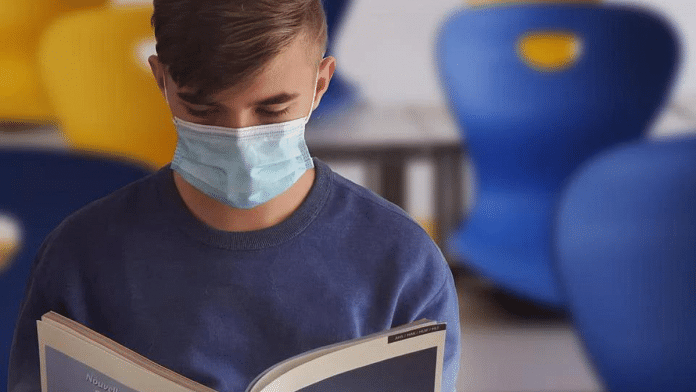While mask-wearing is no longer required in many locations, it remains in use as a way to limit the spread of COVID-19. One of the criticisms of masks has been that they make communication more difficult. A recent report by the UK Department for Education, for example, suggests that mask wearing during the pandemic caused communication difficulties in classrooms.
However, our new research shows that for people without hearing and language difficulties, the effects of face masks on the understanding of speech are in fact mild.
Although face masks slow down our understanding of speech, they rarely lead to misunderstandings. Masks also do not affect our understanding in all situations. They generally only have an effect when the topic of the conversation is unpredictable.
26 children (aged eight to 12) and 26 adults without hearing or language difficulties took part in our study. We showed them videos of a person speaking while wearing a cloth face mask and asked them to repeat back the last word of each sentence they had heard. This allowed us to measure how quickly and how accurately people understand face-masked speech.
As well as testing our participants’ understanding of masked versus non-masked speech, we also manipulated the video in order to test the audio and visual effects of the mask separately. This meant that, for instance, the video showed a non-masked speaker but played audio recorded with the mask on.
We found that children process masked speech up to 8% less accurately and 8% more slowly than normal speech, while adults process masked speech up to 6.5% less accurately and 18% more slowly.
In general, adults responded to speech faster than children in the study – about 23% faster (148 milliseconds) when listening to face mask speech and 29% faster (176 milliseconds) when listening to normal speech. Adults’ highly efficient processing of normal speech could be one reason why the effect of face masks on their speed is more pronounced.
The impact of face masks
Face masks change our use of language in two ways. They change what a speaker sounds like and may give the impression that their speech is muffled. Most masks also block the view of the speaker’s lips.
Surprisingly, our research shows that the way masks change the sound when we speak affects children more than the visual obstruction of the speaker’s lips. The reason for this could be that children are not as good at combining visual information with sound as adults are when hearing and seeing a speaker. As a result, seeing the speaker’s lip movements while hearing masked speech does not improve how accurately they understand what is being said.
This is different from adults, who find masked speech more difficult to understand because of the unique combination of visual blocking and sound changes. We found that acoustically muffled masked speech does not affect adults’ understanding when they can see the speaker’s lip movements. Similarly, concealing the talker’s mouth does not have an effect when the speech sound is clear. However, most masks conceal the mouth and change the speech sound at the same time.
What we’re talking about matters
Interestingly, the topic of conversation matters. Face masks affect our understanding less when we can anticipate what our conversation partner is going to say.
This is because knowing the conversation context helps us to understand language quickly and effortlessly. For example, in the sentence “For your birthday I baked this cake”, the words “birthday” and “baked” are related in meaning to the last word “cake” and often occur together. Our brains can use this information to predict what a speaker is going to say.
Our study shows that giving this type of contextual information reduces the difficulties in understanding masked speech. When given high contextual information, both children and adults process masked speech only 1% less accurately than normal speech. This explains why communicating with masks causes difficulties in some situations but not others.
While there have been fears that masks would affect children’s learning, in the classroom teachers use many techniques that increase contextual information. They design lessons in a way that builds upon students’ existing knowledge and use images, keywords and written text. All of these techniques support children’s understanding of what is being said and help them to compensate for face mask effects.
Listeners also use other clues that reduce mask effects. For example, most masks do not cover the upper part of the face. This is good news because seeing the speaker’s eyes and upper face helps us to understand masked speech better. As a result, our comprehension of language is remarkably robust.
However, participants in our study did not have any hearing or speech difficulties, and only listened to an adult speaker in quiet conditions. We don’t know how mask wearing has affected children’s communication with their peers, or its impact on other aspects of their learning and wellbeing.
PhD Candidate in Linguistics, University of Cambridge
The article was first published at The Conversation.
Also read: Covid has caused a global ‘learning catastrophe’. Reversing damage won’t be enough






